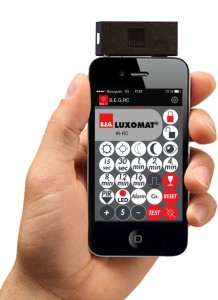The lighting Industry: Then and Now
Paul Jones, B.E.G. UK sales manager for UK and Ireland, looks at the evolution of lighting controls, bringing us up to date with how the new technologies, products and systems in the lighting industry will create greater opportunities to help the environment and save money for end users.
Over the last few years, several factors including political, economic, technological and environmental issues have affected research, development and manufacture within the UK lighting industry.
Major political influence came in 2009, when the European Union began the phase-out of light bulbs for general lighting in favour of more energy-efficient lighting alternatives. The UK Government had already announced in 2007 that incandescent bulbs would be phased out completely by 2011 and the US Government was actively encouraging manufacturers to develop new efficient lighting solutions that saw the introduction of LEDs.
Added to this, the interest in and application of wireless connected devices has become commonplace due largely to the rapid adoption of smartphones and tablet PCs with many facilities managers now wishing to be able to control lighting of buildings and offices in this way.
Installation of smart lighting control systems have continued to grow, offering commercial, domestic and government consumers a means to operate lighting in the most efficient way possible, by making the best use of natural light and only lighting rooms which are occupied.
Smart lighting control systems
In commercial buildings, lighting accounts for up to 40 per cent of total energy cost. Reducing this energy consumption has become a major goal for building owners, governments, utilities and many other stakeholders. It is no secret that replacing existing lights with more energy-efficient lighting sources (such as LED) is one of the ways to reduce this massive pool of energy use – but efficiency is only the start.
UK businesses in recent years have been exploring ways of using smart lighting controls to maximise the use of natural daylight with dimming ballasts, for example, installed within light fittings.
This clever technology uses occupancy sensors to measure the amount of available natural light, compared with the pre-determined light level and automatically turns the fitting on to the required level. In fact, B.E.G. sensors are available in the UK that can set four different lighting bands/zones for the same area using a simple DALI pair. For example, schools require different light levels for the three rows and then separate for the presentation/teacher area.
The lights are controlled by occupancy control but you can also have switches to provide automatic and semi-automatic function, both near the entrance and next to the presentation area and different light levels to ensure an overall balance.
Another key development has been controlling the lights and heating/ ventilation with one sensor that has two channels, so reducing wasted light but also only having the extractor fans on in a washroom when occupied. The run-on times can be set individually and you can also reduce the fan costs by not needing timer controlled models.
For the more sophisticated building management systems you can use sensors that have built-in thermostats. This system reliably detects the three most important values of a room: the room temperature, the light level on the ceiling which transmits the measured values to two 0-10V interfaces and, thirdly, the sensor detects movement and reports this via a switch contact. This information then can be used for closed (proprietary) BUS-systems (e.g. LON or SPS) and DALI-systems.
The real advantage of using a lighting control system compared with a stand-alone lighting control or traditional manual switches is the fact that you can control individual lights or groups of lights from a single user interface device. This technology gives you the opportunity to control several light sources from one user device and create complex lighting environments.
A room can have various scenes already pre-set, based on the activity in a particular room. A major advantage of using a lighting control system such as this is it can result in a huge reduction in energy consumption. The individual lamps will also have a longer shelf live if dimmers are used and lights go off when not being used.
Wireless lighting control systems offer even more benefits including the reduction of installation costs and more flexibility over where switches and sensors can be placed.
Automatic lighting control systems, in summary, can be time dependent (i.e. lights off during breaks and weekends), daylight dependent (for busy working conditions) and presence-dependent (for corridors, staircases and rooms that are seldom used) saving energy and money.
LEDs leading the way
Light-emitting diode (LED) products, due to their significantly increased energy efficiency, have become very popular in a world where energy and resources are growing scarcer and more costly.
Although they have been around in one way or another since the early 1960s, it is only in the past decade that LED technology has developed to a point where it has become both practical and economical to use in a wide variety of applications.
As LEDs have evolved and improved they have become the lighting solution of choice due to their energy efficiency, long lasting nature, flexibility and good colour quality.
The advent of LED technology also brings with it the opportunity to experience exciting new functionality such as colour. Using wireless lighting controls, users will be able to switch, dim, change color, make group colour settings and more.
LEDs use almost 75 per cent less energy and last 25 times longer than incandescent lighting.
The future looks bright
As energy prices continue to increase coupled with ongoing concerns about the environment, organisations across the nation are investing millions to replace out-of-date lighting systems. But the Government could do more to increase uptake. In Denmark, it is mandatory for all Government buildings to be fitted with controls, no ifs and no buts-a MUST! Why can’t the same be set here in the UK?
Already described as the low hanging fruit of energy saving by more than one green expert, the future new technologies, products and systems in the lighting industry will create new opportunities to help the environment, end-users, and make significant cost savings.
Private-sector interest in these advances has been reinforced by public policy, including more stringent energy policies in UK and beyond.
While LEDs play a role in reducing energy consumption across the globe, lighting control systems serve to provide the correct amount of light precisely where and exactly when it is needed. Schools are already experimenting changing the colour of light and the levels in the afternoon to counter circadian rhythms to keep the children more awake to learn.
These systems are also starting to be used to provide more, such as retailers using the technology to push special offers to customers’ smart phones while they browse the store.





